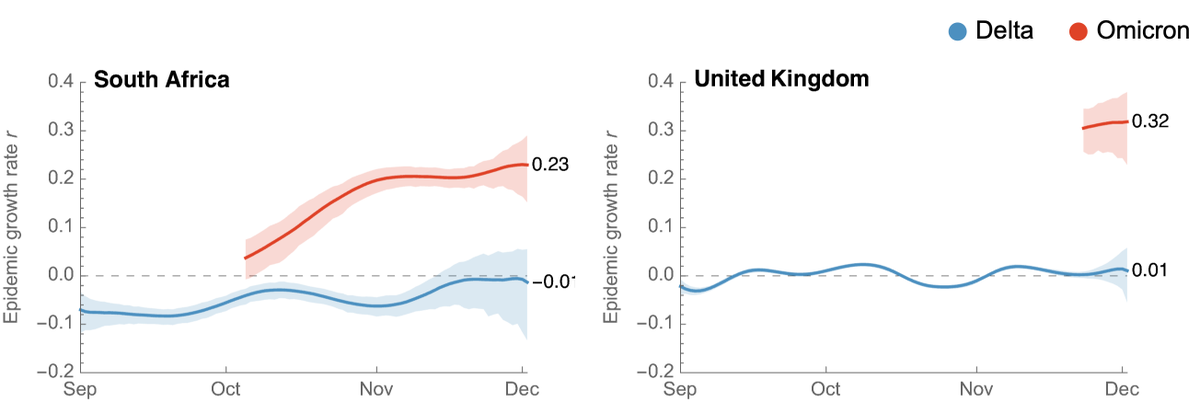
We've seen exceptionally rapid spread of Omicron in South Africa. Although we should expect this rapid spread to follow in other geographies, we've mostly lacked data to confirm this until recently. 1/21
https://twitter.com/trvrb/status/1467245887357210624
Because of significant travel connections (
https://twitter.com/MOUGK/status/1464141177226158094) and extremely strong genomic surveillance by @CovidGenomicsUK, we should have early data from the UK about rate of spread outside of South Africa. 2/21
The UK is sequencing between 5000 and 8000 viruses everyday. Although turnaround times are fast, necessary processing delays permit a view that's basically lagged by ~7 days. Today, I have a strong view of Dec 1 data in @GISAID, but Dec 2 has much less data available to me. 3/21
South Africa is similarly timely in their sequence sharing. We can start by looking at the rate of increase of frequency of Omicron in South Africa and the UK. Here we see that frequency of Omicron has increased from ~0.1% on Nov 23 to almost 1% on Nov 29. 4/21 

As before, we can partition case counts based on variant frequency to estimate variant-specific case counts through time. 5/21 

The exponential increase in Omicron cases in South Africa and the UK is clearly seen as a straight line on a log scale. 6/21 

Continued exponential growth in the intervening days when sequence data is not available is visible from the SGTF data that has less delay. 7/21
https://twitter.com/AlastairGrant4/status/1468648072527978497
To put this in perspective, when Alpha emerged in the UK, its rate of logistic growth was ~0.08 per day (
https://twitter.com/trvrb/status/1351210628921356290). A similar calculation with Omicron gives a current logistic growth rate of ~0.41 per day. 8/21
As before, I'm using results from a modeling approach by @marlinfiggins to estimate variant-specific Rt from @GISAID sequence proportions alongside @OurWorldInData case counts (manuscript and code on GitHub, preprint should be out shortly github.com/blab/rt-from-f…). 9/21
This approach finds that Delta Rt has remained low, while Omicron Rt is between 3 and 4 in South Africa and initial Omicron Rt is ~6 in the UK. 10/21 

These estimates of Rt are sensitive to exact choice of generation interval (here we used Gamma distribution with mean of 5.2 days and sd of 1.72 days). However, we can convert to "little" r epidemic growth rate which doesn't have this generation time assumption. 11/21
Doing so estimates epidemic growth rate in South Africa of r = 0.23, corresponding to a doubling time of 3.0 days [80% CI 2.4-4.6 days], and an epidemic growth rate in the UK of r = 0.32, corresponding to a doubling time of 2.2 days [80% CI 1.8-3.0 days]. 12/21 

Both a three-day doubling and a two-day doubling are very fast, though I could imagine a few factors that might contribute to the UK's current faster rate of spread, including:
1. Seasonality may be more favorable at the moment in the UK
13/21
1. Seasonality may be more favorable at the moment in the UK
13/21
2. Multiple initial seeds from travel introductions will initially spread rapidly but will slow somewhat as the virus percolates further into the community
3. Initial increase will have force of infection from travel introductions alongside local growth
14/21
3. Initial increase will have force of infection from travel introductions alongside local growth
14/21
Active case finding and preferential sequencing of SGTF specimens should increase the overall rate of detection in the UK, but I don't see how this could result in the large temporal increase in Omicron cases seen here. 15/21
As initial seeds percolate and grow further, I would expect rate in the UK to slow to be closer to what's currently observed in South Africa, but this is still exceptionally rapid spread. 16/21
That said, we're now perhaps seeing indications of slowing of spread in South Africa from the latest case count data. The size of the South Africa wave will now be determined by how quickly Rt drops below 1. 17/21
https://twitter.com/tomtom_m/status/1468880109482487809
As before, I believe a significant Omicron wave is inevitable and we should be doing our best to prepare for it now. 18/21
https://twitter.com/trvrb/status/1467245923939983361
Due to immune escape phenotype, Omicron has available to it a much larger fraction of the population than Delta. This causes a larger proportion of cases to be breakthrough cases or reinfections. 19/21
I believe this can likely explain a large degree (and potentially all) of the reduction of severity that's been observed so far. In general immunity is more robust to severe outcomes than infection. 20/21
Based on available data, I don't feel comfortable yet speculating quantitatively about severity in the UK, US, etc..., but whatever level of severity it comes in at will determine how bad the inevitable Omicron wave will be. 21/21
• • •
Missing some Tweet in this thread? You can try to
force a refresh








